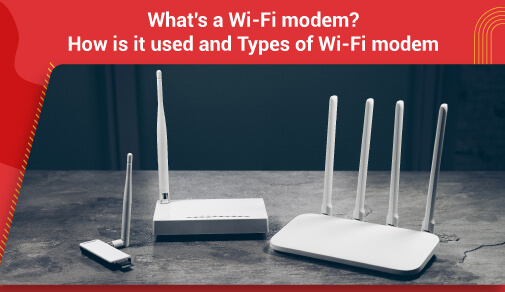What's a WiFi modem? How is it used and what types are there?
Saturday, Jun 08, 2024 · 5 minutes


WHAT'S A WIFI MODEM? HOW IS IT USED AND WHAT TYPES ARE THERE?
Saturday, Jun 08, 2024 · 5 minutes
A modem is a fundamental gadget for internet availability that assists your home network and your Internet Service Provider (ISP) in interpreting information signals. A WiFi modem is a flexible gadget that joins the features of a modem and a remote switch to make setting up and keeping up with your network framework more straightforward. How about we look at the different varieties of WiFi modems that are accessible and available, as well as their various applications?
Essentially, a modem, short for modulator-demodulator, goes about as the interfacing component between your home network and the more extensive web climate. Fundamentally, it changes computerized signals from your gadgets into a configuration that can be communicated across the organization framework of your ISP as well as the other way around. A computerized span interfaces your nearby network to the limitlessness of the Internet.
In the domain of modems, there exists a spectrum of types of wifi modems tailored to cater to diverse connectivity requirements and infrastructural nuances. These encompass:
1. DSL Modems: These modems link to telephone lines to send data signals. They are primarily used in situations where Digital Subscriber Line (DSL) technology acts as the conduit for internet connectivity.
2. Cable Modems: By converting data signals for flawless transmission, cable modems operate in areas where cable broadband dominates. They do this by utilizing the coaxial cables that are commonly associated with cable television infrastructure.
3. Fibre Optic Modems: Fibre optic modems are at the forefront of a new era of high-speed internet as fiber optic networks become more and more commonplace. They facilitate the translation of data signals between optic fibers.
The router distributes the signal to the network's devices, and the modem is in charge of sending and receiving signals from the ISP. The modem is connected to the router, which is connected to every device on the network in a standard home network configuration.
The router distributes the signal to all of the network's devices while the modem sends and receives signals from the ISP. The router is connected to every device on the network after the modem in a typical home network configuration.
Let's dig deeper into the use of modems. A WiFi modem represents a potent amalgamation of traditional modem functionalities with the wireless prowess of a router, furnishing users with an all-encompassing solution for their networking needs. Let's unpack the manifold benefits and applications of WiFi modems:
Smooth Wireless Networking: WiFi modems, which incorporate wireless router functions, free users from physical cable restrictions and allow internet signals to be wirelessly distributed to a wide range of devices within the network range.
Simplified Setup and Configuration: WiFi modems facilitate the process of network establishment by offering customers an easy-to-use configuration interface and intuitive setup methods. This allows users to browse through the setup details with ease.
Enhanced Network Security: WiFi modems, equipped with strong encryption protocols and firewall features, strengthen network security by providing protection against unauthorized access and possible cyber dangers that may be hiding in the digital ether.
A Wi-Fi modem is a device that modulates and demodulates digital data from your internet service provider (ISP) into a Wi-Fi signal. This conversion allows wireless internet connectivity for various devices within its range. Within the realm of types of wireless modems, an expansive gamut of types exists, each tailored to cater to specific connectivity requisites and performance benchmarks. These encompass:
Single-Band Modems: Functioning inside the 2.4 GHz frequency range, single-band modems operate admirably in settings with low levels of wireless interference.
Dual-Band Modems: Using both the 2.4 GHz and 5 GHz frequency bands, dual-band modems increase throughput rates while lessening the effects of wireless congestion.
Mesh WiFi Systems: The ultimate in wireless networking sophistication, mesh WiFi systems adopt a decentralized network architecture instead of the conventional modem-router paradigm, enabling smooth coverage and optimal performance across large areas.
When venturing into the realm of WiFi modems, a confluence of factors warrants consideration to ensure optimal performance and alignment with your networking requisites:
Speed and Throughput: Consider the velocity and throughput capacities of potential WiFi modems, making sure that they meet your bandwidth needs and usage habits.
Coverage and Range: Evaluate WiFi modems' coverage and range to determine how well they work to deliver dependable connectivity throughout your building.
Security Features: Examine the security features that WiFi modems provide. To protect against any cyber threats, give strong encryption protocols and firewall functions top priority.
Although a WiFi modem is an essential component of any networking setup, adding a dedicated router to your configuration can improve connectivity and simplify network administration. Users can get several advantages by shifting wireless routing functions to a standalone router, such as improved network customization, cutting-edge security capabilities, and smooth interaction with new networking technologies.
A WiFi modem, also known as a modem, connects your home network to your internet service provider (ISP). It translates the signals from your ISP into a digital signal that your WiFi router can broadcast.
Function: A modem acts like a translator, converting the signals from your ISP into a format that your WiFi router can broadcast.
Connection: Modems typically plug into an outlet and connect to a router, which then connects to your devices.
Types: There are different types of modems, including cable, telephone, satellite, dial, and digital subscriber line (DSL).
To sum up, WiFi modems combine the essential features of a modem with the wireless capabilities of a router to represent the height of networking innovation. Equipped with a sophisticated comprehension of the various kinds, uses, and variables that influence their choice, users can set out on a revolutionary path to building a strong and durable network architecture, such as ACT's Fibernet WiFi connections with their affordableWiFi plans, ready to satisfy the expanding needs of the modern day.
90

The New Social: How High-Speed Internet is Redefining 'Quality Time' with Friends and Family
Read more320

How ACT SmartWi-Fi is Redefining Home Internet in 2025: The Age of AI-Powered Seamless Connectivity
Read more129

From Bandwidth to Intelligence: How AI Is Redefining Business Demands from ISPs
Read more
A referral link has been sent to your friend.
Once your friend completes their installation, you'll receive a notification about a 25% discount on your next bill
![]() Please wait while we redirect you
Please wait while we redirect you

![]() One of our representatives will reach out to you shortly
One of our representatives will reach out to you shortly

One of our representatives will reach out to your shortly
![]() Please wait while we redirect you
Please wait while we redirect you

Please enter your registered phone number to proceed

Please enter correct OTP to proceed


Dear customer you are successfully subscribed
Please wait while we redirect you

Your ACT Shield subscription has been successfully deactivated

Dear user, Your account doesn't have an active subscription

Dear customer Entertainment pack is already activated.
Please wait while we redirect you